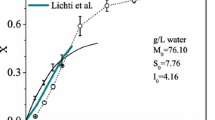Abstract
Coagulation of latex particles is most often carried out in the diffusion limited aggregation (DLA) regime where the time for coagulation to take place is on the millisecond timescale. This process produces aggregates of low density, irregular shape, and a broad particle size distributions. When the coagulation is carried out in the reaction limited aggregation (RLA) regime, a coagulation time of about 1–120 sec, the system can be controlled by mixing to yield dense, spheroidal aggregates with a very narrow particle size distribution. The important variables in the RLA process for butyl acrylate/methyl methacrylate (BA/MMA) latexes were found to be mixing intensity, latex copolymer composition, and coagulation temperature. Dried aggregates formed in the RLA process were found to have excellent powder flow properties and low dustiness.
Similar content being viewed by others
References
Botet, R. and Jullien, R., “Size Distribution of Clusters in Irreversible Kinetic Aggregation,” J. Phys. A: Math. Gen., 17, 2517 (1984).
Botet, R. and Jullien, R., “Hierarchical Model for Chemically Limited Cluster-Cluster Aggregation,” J. Phys. A: Math. Gen., 17, L639 (1984).
Family, F., Meakin, P., and Vicsek, T., “Cluster Size Distribution in Chemically Controlled Cluster-Cluster Aggregation,” J. Chem. Phys., 83, No. 8, 4144 (1985).
Yusa, M., “Mechanisms of Pelleting Flocculation,” Int. J. Miner. Process, 4, 293 (1977).
Yusa, H., Hoshino, M., and Isaka, H. (to Kureha Kagaku Kogyo Kabushiki Kaisha) UK Patent GB 2157297 (1988).
Iwasaki, T., Momose, K., and Sakabe, H., “Particle Formation from Polymer Emulsion unders Slow Coagulation Condition,” Kagaku Kogaku Ronbunshu, 16, No. 4, 627 (1990).
Hopper, M., Patel, R., and Kmiecik-Lawrynowicz, G. (to Xerox Corp.) U.S. Patent 5525452 (1996).
Derjaguin, B. and Landau, L., Acta Physicochim., USSR, 14, 633 (1941).
Vervey, E. and Overbeek, J., Theory of the Stability of Lyophobic Colloids, Elsevier, Amsterdam, the Netherlands, 1949.
von Smoluchowski, M., Bull. Int. Acad. Polon. Sci., Classe Sci. Math. Nat., 184 (1903).
Mills, P., Goodwin, J., and Grover, B., “Shear Field Modification of Strongly Flocculated Suspensions—Aggregate Morphology,” Colloid Polyn. Sci., 269, 949 (1991).
Author information
Authors and Affiliations
Rights and permissions
About this article
Cite this article
Kostansek, E. Controlled coagulation of emulsion polymers. J Coat. Technol. Res. 1, 41–44 (2004). https://doi.org/10.1007/s11998-004-0023-1
Issue Date:
DOI: https://doi.org/10.1007/s11998-004-0023-1




